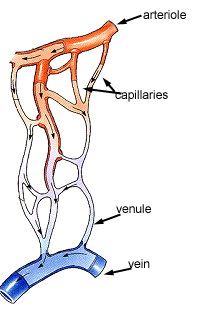Venules and Veins

To return blood to the heart, there is a series of venules, veins, and muscular veins. Venules have much larger lumina and thinner walls than corresponding arterioles. Similarly, the veins are distinguishable from arteries and arterioles, because their walls are much thinner, compared to the diameter of their lumen.
The venous return from the legs is aided by contraction of skeletal muscle, which compresses the veins inside them, and the veins of medium size also have valves in them, to overcome the problem of reverse flow.
The veins still have the three basic layers (tunica adventitia, tunica media and tunica intima), but the elastic and muscular components are less prominent. The smooth muscle layers are used to contract or dilate the veins, to accommodate changes in blood volume.
Venules
These have a clear tunica intima layer, without any elastic fibres, and a tunica media with one or two layers of muscle fibres. The tunica adventitia fuses with surrounding tissue.
Look at this photograph of a venule, and identify the lumen (containing red blood cells) and endothelial cells.
Veins
In a section that has both arteries and veins, the artery and veins are very easy to tell apart. The thickness of the walls of the veins is much less, compared to the lumen, and the lumen is often collapsed as shown here.
Can you identify which is the artery and which is the vein in this picture?
In this higher power image of part of the vein shown above, can you identify the three layers of the vein:
Tunica Intima: A thin endothelial lining, (in some veins, you may be able to see the valves).
Tunica Media: This layer contains 2-3 layers of muscle cells.
Tunica Adventitia: This is the broadest layer. It contains longitudinal collagen fibres, and vasa vasorum.
Muscular veins
This is an image of a muscular vein.
Can you identify the three layers, tunica intima (thin flattened endothelial cells), the thick muscular wall (tunica
media) and the adventitia layer, which has vasa vasorum.These blood vessels are much more numerous than in arteries of a similar size.
Unlike muscular arteries, there is no internal or external elastic layer surrounding the muscle layer (why do you think this is?).
Compare the structures of the vein and muscular vein.
